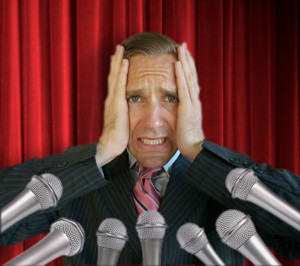The Speakers Practice has invited Australian Small Business owners to submit articles on the topic of the Presentation Skills in the workplace. Contributors are experts in their industry , discussing the value of presentation skills in their field of expertise.
Introducing Amber Daines
Amber Daines, Founder of Bespoke Communications and a member of the Media Skills™Network
Wading through the media sound bites that resonate the airwaves, fill ours newspapers, and clog our in-boxes, its easy to think we are all just passive players in the relentless public relations machine. As a former journalist turned PR professional / media trainer, I am guilty of adding to the case but am here to argue the real damage is done when the talent is not trained at all.
Good media training builds on presentation skills and will never detract away from the key message of the speaker. It takes a discipline and practice to ensure you make your point, back it up, wrap it up and shut up – all within the limited time given for that 10-second grab or one liner that makes a front page headline or 140 character tweet. Authenticity and passion are key as well as sharinhg stories, being informative and remembering your audience.
Most PR professionals will attest to sleepless nights worrying how their client will deliver the goods on a TV, radio or print interview. And it is not about your strategy or the client’s knowledge. The CEO or whoever is worthy of a journalist’s attention generally knows their company or the issues they face inside out. What they may struggle with is the delivery when the heat is on.
My job is to really ensure that even the most reluctant interview participants are put through their paces. Most fess up afterward that the experience has added value to their brand, their company, their careers. Good training is about the confidence to be interviewed by a reporter and walk away happy with the outcome.
Spokespeople need to know how to stay on message and to understand that an interview is not a regular conversation between two people. There is a very different give and take and purpose in an interview, and interviewees need to be able to recognise that.
I believe that the true value of media training is often not fully appreciated until one experiences the benefits for themselves – benefits that extend beyond the realms of the media interview.
As a former news journalist, I know that the most memorable, even award-winning reporting comes from interviewees who make a shock confession in an “off the record” chat or make a gaff that gets them on Youtube for all the wrong reasons.
Most seasoned journalists can still get under the skin of the most astute media performers. It’s fair to say that media training rarely registers on a journalist’s radar when they’re interviewing someone – although that is changing thanks to auto-pilot politicians and self-styled celebrities who are so obviously trained to repeat key messages ad nauseum.
For media training to work well, the end game is that a journalist should walk away with a good story that they publish. The resulting interview should be smooth, the content kept varied and answers must be devoid of phrases that sound like spin. Appropriate tone of voice and convincing body language is also vital for visual mediums.
Having seen the benefits for many clients – from CEOs to political leaders to SME owners – the best media training delivers something newsworthy with crisp quotes and tangible examples. This folks is what matters for your clients and your business.
I always think of media training as bullet proofing your PR campaign. In the hogwash of the 24/7 news cycle, stakes are high every time anyone speaks to a journalist so why just “wing it”?
Thanks Amber. Giving us an insight into the media world, this helps all small business people to promote their business. After all, its all about the marketing. Great article!





